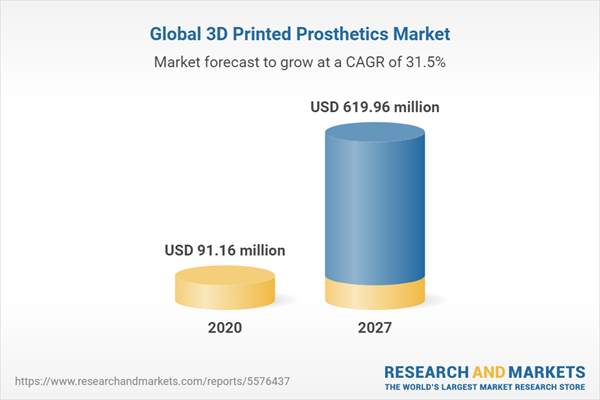One of the most notable applications of 3D printing has been in the health and medical industry, which has seen rapid growth in recent years. Prosthetics have been the most successful of these innovations so far, but everything from medications to human organs has been printed. Traditional prosthetics costs in the range of $1,500 to $8000, according to the American Orthotics and Prosthetics Association. Patients often pay for them out of pocket instead of through insurance. 3D printed prosthetics, on the other hand, cost as low as just $50! It is also possible to make prosthetic limbs faster using 3D printing; limbs can be printed within a day. Additionally, patients enjoy the opportunity to customize their purchases, another factor that appeals to them. The color and style can be customized to suit their needs and desires. Thus, the 3D printing prosthetics market is expected to grow in the forecast period.
Prosthetics made with 3D printing can use acrylonitrile butadiene styrene (ABS) plastics or anything stronger like Bridge nylon. Other materials, such as lightweight titanium, are now compatible with 3D printers, improving durability and strength. Research has been conducted to develop the technology further. Scientists at Hasselt University in Belgium used a laser to melt thin layers of titanium powder to fabricate and implant the world's first 3D-printed titanium mandibular prosthesis. Further, Oxford Performance Materials (OPM) successfully implanted a 3D printed polyetherketoneketone (PEKK) skull implant approved by the FDA. Another company, 3D Systems specializes in manufacturing titanium orthopedic and spinal implants. In an effort to create a prosthetic ear that detects electromagnetic frequencies, a 3D printed model made of silicon, chondrocytes, and silver nanoparticles has been developed.
Growth Factors:
The market is growing as a result of constant research and development
The fact that 3D printing is becoming widely available in prosthetics means that a prosthetic procedure will be available even to a common person soon. People who require prosthetic surgery would be quite satisfied with the cost as the traditional method has been very expensive. 3D printing has significantly reduced the cost. With CAD, it is extremely easy to modify the designs, as well as a very low cost for production. It offers a realistic alternative to bionic hands precisely for this reason. Considering 3D printing and prosthetics applications, speed is also an important consideration. By using 3D printing, prosthetics can be made faster than traditional prosthetics. It takes traditional prosthetic makers weeks or even months to make one prosthetic. However, this is changing with 3D printing. There are nearly 2 million people with limb loss in the United States alone, according to Amputee Coalition. There are approximately 185,000 amputations performed each year in the United States, resulting from a variety of causes. Today, there are many companies that are investing in 3D printed prosthetics and making them more accessible. An automated production line for low-cost, personalized prosthetic limbs is to be developed by scientists at the Israel Institute of Technology in March 2021. Unlimited Tomorrow, a company that manufactures prosthetic limbs, has introduced TrueLimb at CES 2020, a fully remote 3D prosthetic arm that amputees can get by logging on to their online accounts. Further, in August 2021, a team of researchers from MIT and Shanghai Jiao Tong University has created an inflatable prosthetic hand that costs a fraction of comparable prosthetics. The inflatable hand, however, is made from light, soft material and has a cost of $500 instead of US$10,000 for metal limb neuroprosthetics. Due to the increasing demand for 3D prosthetics, companies are constantly announcing new technologies and developing new products, thus, driving the market growth.
Restraints
Durability
Even though the cost is quite low of artificial limbs, the durability remains a concern. In comparison with the traditional prosthetic limbs, the limbs printed by amateurs tend to break more frequently. The FDA does not approve limbs printed with 3D printing, which tests issues of durability.
Segmentation
By Type
- Sockets
- Limbs
- Joints
- Covers
- Others
By Offering
- Products
- Services
By Geography
- North America
- USA
- Canada
- South America
- Europe
- Germany
- France
- United Kingdom
- Others
- Middle East and Africa
- Asia Pacific
- China
- South Korea
- Japan
- Others
Table of Contents
1. INTRODUCTION1.1. Market Definition1.2. Market Segmentation
2. RESEARCH METHODOLOGY2.1. Research Data
2.2. Assumptions
3. EXECUTIVE SUMMARY3.1. Research Highlights
4. MARKET DYNAMICS4.1. Market Drivers
4.2. Market Restraints
4.3. Porters Five Forces Analysis
4.3.1. Bargaining Power of Suppliers
4.3.2. Bargaining Powers of Buyers
4.3.3. Threat of Substitutes
4.3.4. The threat of New Entrants
4.3.5. Competitive Rivalry in Industry
4.4. Industry Value Chain Analysis
5. 3D PRINTED PROSTHETICS MARKET, BY TYPE5.1. Introduction
5.2. Sockets
5.3. Limbs
5.4. Joints
5.5. Covers
5.6. Others
6. 3D PRINTED PROSTHETICS MARKET, BY OFFERING6.1. Introduction
6.2. Products
6.3. Services
7. 3D PRINTED PROSTHETICS MARKET, BY GEOGRAPHY7.1. Introduction
7.2. North America
7.2.1. United States
7.2.2. Canada
7.3. South America
7.4. Europe
7.4.1. Germany
7.4.2. France
7.4.3. United Kingdom
7.4.4. Others
7.5. Middle East and Africa
7.6. Asia Pacific
7.6.1. China
7.6.2. South Korea
7.6.3. Japan
7.6.4. Others
8. COMPETITIVE ENVIRONMENT AND ANALYSIS8.1. Major Players and Strategy Analysis
8.2. Emerging Players and Market Lucrativeness
8.3. Mergers, Acquisition, Agreements, and Collaborations
8.4. Vendor Competitiveness Matrix
9. COMPANY PROFILES9.1. E-Nable
9.2. Bionicohand
9.3. YouBionic
9.4. UNYQ
9.5. Mecuris
9.6. LimbForge, Inc.
9.7. Open Bionics
9.8. Protosthetics
Companies Mentioned
- e-NABLE
- Bionicohand
- YouBionic
- UNYQ
- Mecuris
- LimbForge, Inc.
- Open Bionics
- Protosthetics
Table Information
| Report Attribute | Details |
|---|---|
| No. of Pages | 93 |
| Published | January 2022 |
| Forecast Period | 2020 - 2027 |
| Estimated Market Value ( USD | $ 91.16 million |
| Forecasted Market Value ( USD | $ 619.96 million |
| Compound Annual Growth Rate | 31.5% |
| Regions Covered | Global |
| No. of Companies Mentioned | 8 |









